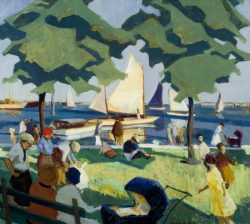Charles E. Mullin 1885–1957
Chicago native Charles Edward Mullin trained at the Art Institute of Chicago’s school under Karl Buehr and sculptor Charles Mulligan and at the Chicago Academy of Fine Arts (founded in 1902) under portrait painter Wellington Reynolds. Mullin was a teacher, printmaker, and sculptor as well as painter. He participated in the so-called “Salon de Refusés” exhibition of 1921, which featured work rejected by the jury for the Art Institute’s annual “Chicago and Vicinity” salon. Mullin became active in the succeeding independent artists’ movement, serving as vice-president of the Chicago No-Jury Society of Artists from 1926 to 1931.
As the Art Institute became increasingly receptive to modernism in the late 1920s, Mullin’s work began to be juried into its annual exhibitions. He was awarded the Edward B. Butler Purchase Fund Prize in 1929; the following year he was a recipient of the Fine Arts Building Purchase Prize of $500 for his painting Suburban Garden, which was reproduced in three Chicago newspapers. Also in 1930, he was the subject of one of the museum’s small summer solo shows, sharing a gallery with another Chicago modernist painter, Emil Armin. Reviewing Mullin’s “amusing” works, Chicago Tribune art critic Eleanor Jewett noted that “his is a solid mirth, carefully limned, built up with intention and deliberation. Armin chuckles, where Mullin guffaws.”i Several of Mullin’s paintings in the show were purchased for local schools but their current whereabouts are unknown. Mullin also exhibited at the Renaissance Society, a progressive venue at the University of Chicago.
Mullin worked for much of his life as a postal clerk in Chicago. Beginning in 1925 he was a resident of southwest-suburban Orland Park. He was a member of the Chicago Society of Artists, the South Side Art Association, the Illinois Academy of Fine Arts, and the Ridge Art Association. In 1939 Mullin was one of several South Side artists whose oil and watercolor paintings were shown at Mandel Brothers, a downtown department store, and in the 1940s his works (probably prints) were included in exhibitions at the Library of Congress, the Laguna Beach Art Association in Southern California, and the Philadelphia Print Club. Little is known of Mullin’s career thereafter. He died in Costa Mesa, California, at age seventy-one.
Wendy Greenhouse, PhD
i Eleanor Jewett, “Snow Pictures Offer Contrast at Art Show,” Chicago Tribune, July 24, 1930.
